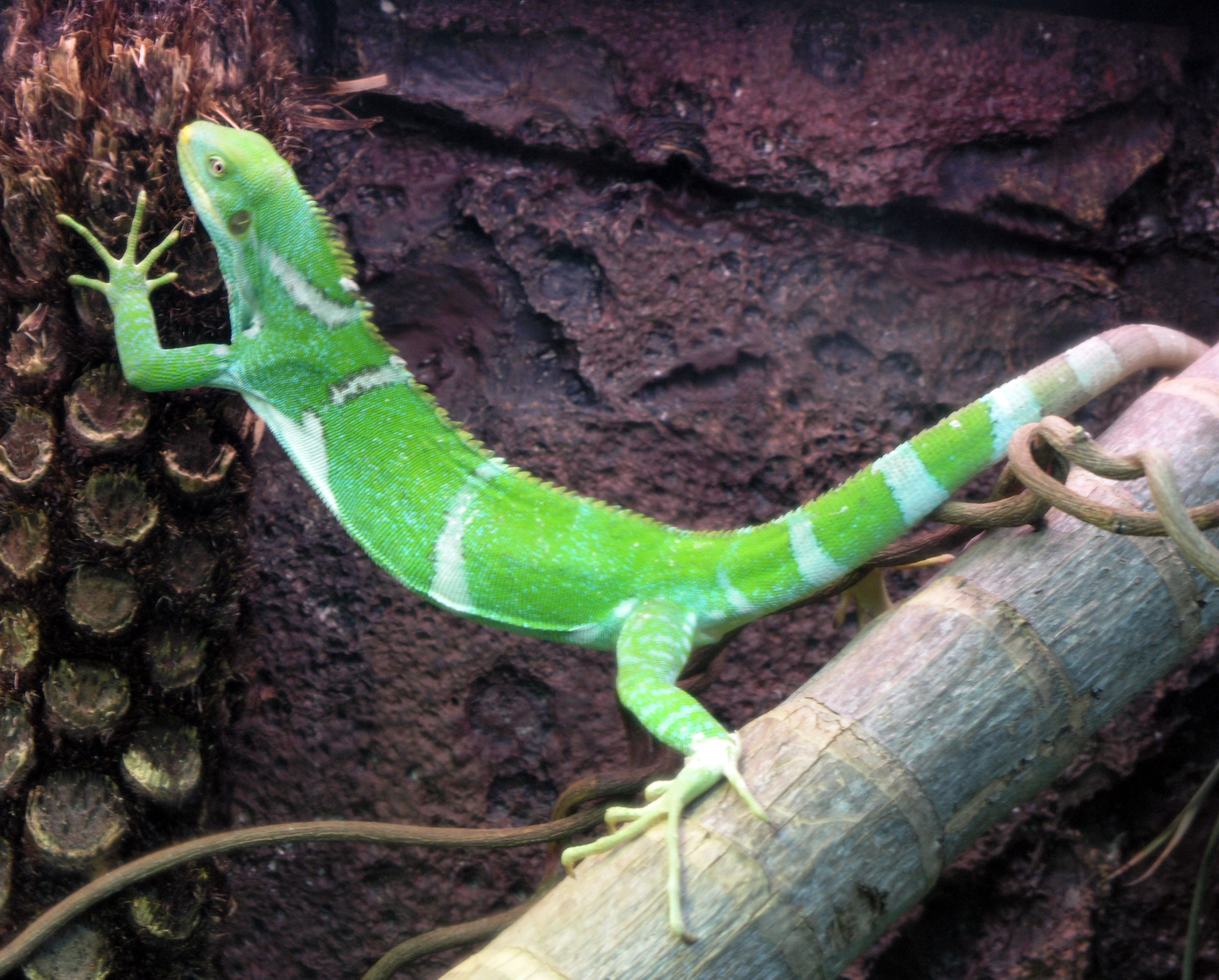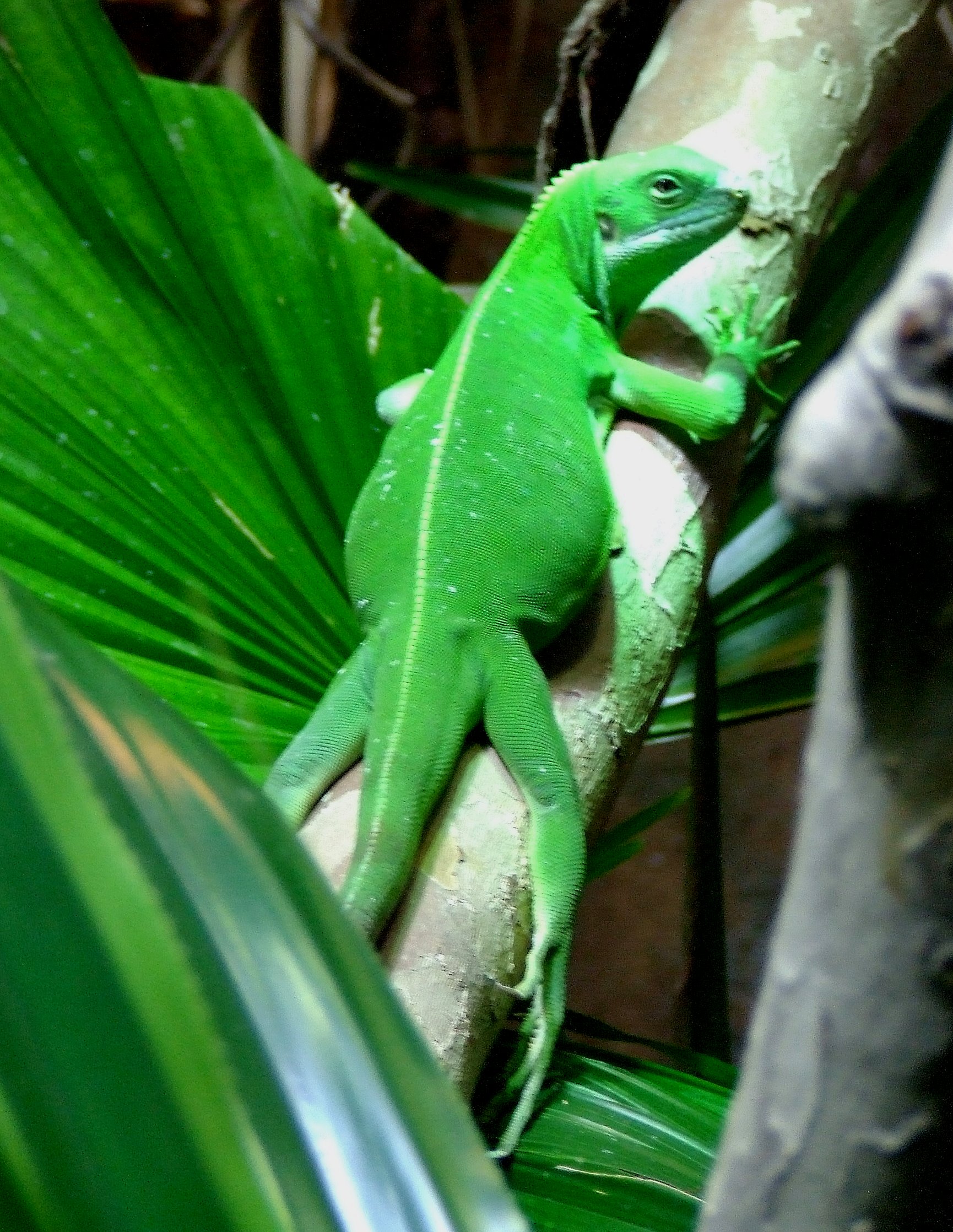|
Fiji Crested Iguana
The Fiji crested iguana or Fijian crested iguana (''Brachylophus vitiensis'') is a critically endangered species of iguanidae, iguana native to some of the northwestern islands of the Fijiian archipelago, where it is found in tropical dry forest, dry forest on Yaduataba (west of Vanua Levu), Yadua, Macuata, Yaquaga, Devuilau (Goat island), Malolo, Monu and Monuriki. Discovery The discovery of ''B. vitiensis'' resulted from herpetologist Dr. John Gibbons of the University of the South Pacific being invited to a screening of the movie ''The Blue Lagoon (1980 film), The Blue Lagoon''. Part of the movie was filmed on a Nanuya Levu, remote island in Fiji and shots of the native wildlife, including a large colorful iguanid, were included. Gibbons, who was studying the Fiji banded iguana at the time, traveled to the island and identified the lizard in the film as a distinct species new to science. Taxonomy and etymology The genus, generic name, ''Brachylophus'', is derived from two Gre ... [...More Info...] [...Related Items...] OR: [Wikipedia] [Google] [Baidu] |
Melbourne Zoo
Melbourne Zoo is a zoo in Melbourne, Australia. It is located within Royal Park in Parkville, approximately north of the centre of Melbourne. It is the primary zoo serving Melbourne. The zoo contains more than 320 animal species from Australia and around the world, and is accessible via Royal Park station on the Upfield railway line, and is also accessible via tram routes 58 and 19, as well as by bicycle on the Capital City Trail. Bicycles are not allowed inside the zoo itself. The Royal Melbourne Zoological Gardens is a full institutional member of the Zoo and Aquarium Association and the World Association of Zoos and Aquariums. The zoo is set among flower gardens and picnic areas. Many of the animals are now organised in bioclimatic zones: African rainforest ('Gorilla Rainforest') that include gorillas and lemurs; Asian rainforest ('Trail of the 'Elephants') that includes elephants, orangutans, tigers and otters; and the Australian bush with kangaroos, koalas, wombats, ... [...More Info...] [...Related Items...] OR: [Wikipedia] [Google] [Baidu] |
National Trust Of Fiji
The National Trust of Fiji is a statutory organization in Fiji devoted to conservation of public resources. The trust was created in 1970 by the National Trust for Fiji Act. It administers parks and various historical sites. The parks are Sigatoka Sandunes National Park, Sovi Basin, JH Garrick Memorial Park, Waisali Forest Reserve, Momi Battery Historic Park, and Yaduataba Crested Iguana Sanctuary. The National Trust's primary purposes are preservation of historic and natural resources; promotion and augmentation of the amenities to those resources; conservation of flora and fauna; and provision of access to the historic and natural resources for the public. External links Fiji Visitors BureauNational Trust for Fiji Act Fiji Fiji ( , ,; fj, Viti, ; Fiji Hindi: फ़िजी, ''Fijī''), officially the Republic of Fiji, is an island country in Melanesia, part of Oceania in the South Pacific Ocean. It lies about north-northeast of New Zealand. Fiji consists ... [...More Info...] [...Related Items...] OR: [Wikipedia] [Google] [Baidu] |
Brachylophus
The genus ''Brachylophus'' consists of four extant iguanid species native to the islands of Fiji and a giant extinct species from Tonga in the South West Pacific. One of the extant species, ''B. fasciatus'', is also present on Tonga, where it has apparently been introduced by humans. Etymology and taxonomy The name, ''Brachylophus'', is derived from two Greek words: brachys (βραχύς) meaning "short" and lophos (λόφος) meaning "crest" or "plume", denoting the short spiny crests found along the backs of these species. ''Brachylophus'' species are the most geographically isolated iguanas in the world. Their closest extant relatives (the genera ''Amblyrhynchus'', ''Conolophus'', ''Ctenosaura'', ''Cyclura'', ''Iguana'' and '' Sauromalus'') are present in primarily tropical regions of the Americas and islands in the Galápagos and Lesser and Greater Antilles. Several of these genera are adapted to xeric biomes. Phylogenetic evidence supports the ''Brachylophus'' lineage to ... [...More Info...] [...Related Items...] OR: [Wikipedia] [Google] [Baidu] |
Mongoose
A mongoose is a small terrestrial carnivorous mammal belonging to the family Herpestidae. This family is currently split into two subfamilies, the Herpestinae and the Mungotinae. The Herpestinae comprises 23 living species that are native to southern Europe, Africa and Asia, whereas the Mungotinae comprises 11 species native to Africa. The Herpestidae originated about in the Early Miocene and genetically diverged into two main genetic lineages between 19.1 and . Etymology The English word "mongoose" used to be spelled "mungoose" in the 18th and 19th centuries. The name is derived from names used in India for ''Herpestes'' species: or in classical Hindi; in Marathi; in Telugu; , and in Kannada. The form of the English name (since 1698) was altered to its "-goose" ending by folk etymology. The plural form is "mongooses". Characteristics Mongooses have long faces and bodies, small, rounded ears, short legs, and long, tapering tails. Most are brindled or grizzly; a few h ... [...More Info...] [...Related Items...] OR: [Wikipedia] [Google] [Baidu] |
Leucaena
''Leucaena'' is a genus of flowering plants in the mimosoid clade of the subfamily Caesalpinioideae of the family Fabaceae. It contains about 24 species of trees and shrubs, which are commonly known as leadtrees. They are native to the Americas, ranging from Texas in the United States south to Peru. The generic name is derived from the Greek word λευκός (''leukos''), meaning "white," referring to the flowers. Uses ''Leucaena'' species are grown for their variety of uses, including as green manure, a charcoal source, livestock fodder, and for soil conservation. The seeds (jumbie beans) can be used as beads. ''Leucaena'' planted for firewood on an area of will yield an energy equivalent of 1 million barrels of oil per year. Anthelmintic medicines are made from extracts of ''Leucaena'' seeds in Sumatra, Indonesia. Some species (namely ''Leucaena leucocephala'') have edible fruits (as unripe) and seeds. The seeds of ''Leucaena esculenta'' (in Mexico called ''guaje'' or ''hua ... [...More Info...] [...Related Items...] OR: [Wikipedia] [Google] [Baidu] |
Totem
A totem (from oj, ᑑᑌᒼ, italics=no or ''doodem'') is a spirit being, sacred object, or symbol that serves as an emblem of a group of people, such as a family, clan, lineage, or tribe, such as in the Anishinaabe clan system. While ''the word'' totem itself is an anglicisation of the Ojibwe term (and both the word and beliefs associated with it are part of the Ojibwe language and culture), belief in tutelary spirits and deities is not limited to the Ojibwe people. Similar concepts, under differing names and with variations in beliefs and practices, may be found in a number of cultures worldwide. The term has also been adopted, and at times redefined, by anthropologists and philosophers of different cultures. Contemporary neoshamanic, New Age, and mythopoetic men's movements not otherwise involved in the practice of a traditional, tribal religion have been known to use "totem" terminology for the personal identification with a tutelary spirit or spirit guide. However, this ... [...More Info...] [...Related Items...] OR: [Wikipedia] [Google] [Baidu] |
Fiji Crested Iguana444
Fiji ( , ,; fj, Viti, ; Fiji Hindi: फ़िजी, ''Fijī''), officially the Republic of Fiji, is an island country in Melanesia, part of Oceania in the South Pacific Ocean. It lies about north-northeast of New Zealand. Fiji consists of an archipelago of more than 330 islands—of which about 110 are permanently inhabited—and more than 500 islets, amounting to a total land area of about . The most outlying island group is Ono-i-Lau. About 87% of the total population of live on the two major islands, Viti Levu and Vanua Levu. About three-quarters of Fijians live on Viti Levu's coasts: either in the capital city of Suva; or in smaller urban centres such as Nadi—where tourism is the major local industry; or in Lautoka, where the sugar-cane industry is dominant. The interior of Viti Levu is sparsely inhabited because of its terrain. The majority of Fiji's islands were formed by volcanic activity starting around 150 million years ago. Some geothermal activity st ... [...More Info...] [...Related Items...] OR: [Wikipedia] [Google] [Baidu] |
Oviparous
Oviparous animals are animals that lay their eggs, with little or no other embryonic development within the mother. This is the reproductive method of most fish, amphibians, most reptiles, and all pterosaurs, dinosaurs (including birds), and monotremes. In traditional usage, most insects (one being ''Culex pipiens'', or the common house mosquito), molluscs, and arachnids are also described as oviparous. Modes of reproduction The traditional modes of reproduction include oviparity, taken to be the ancestral condition, traditionally where either unfertilised oocytes or fertilised eggs are spawned, and viviparity traditionally including any mechanism where young are born live, or where the development of the young is supported by either parent in or on any part of their body. However, the biologist Thierry Lodé recently divided the traditional category of oviparous reproduction into two modes that he named ovuliparity and (true) oviparity respectively. He distinguished the ... [...More Info...] [...Related Items...] OR: [Wikipedia] [Google] [Baidu] |
Hibiscus Tiliaceus
''Hibiscus tiliaceus'', commonly known as the sea hibiscus or coast cottonwood, is a species of flowering tree in the mallow family, Malvaceae, with a pantropical distribution along coastlines. It has also been introduced to Florida and New Zealand. It has been debated whether this species is native or introduced to Hawaii. Names Common names include sea hibiscus, beach hibiscus, coastal (or coast) hibiscus, coastal (or coast) cottonwood, green cottonwood, native hibiscus, native rosella, cottonwood hibiscus, kurrajong, sea rosemallow and dhigga ( Maldivian). The plant was introduced by Austronesian peoples that voyaged across Southeast Asia and Oceania as a source of wood and fibre. This is reflected in the names of the plant as spoken in many related languages spoken in those regions including ''balibago'' ( Tagalog), ''malobago'' ( Bikol), ''malabago'' or ''malbago'' ( Cebuano – Southern), ''maribago'' ( Cebuano – Northern), ''lambago'' (Cebuano - Cagayan de Oro), ... [...More Info...] [...Related Items...] OR: [Wikipedia] [Google] [Baidu] |
Herbivorous
A herbivore is an animal anatomically and physiologically adapted to eating plant material, for example foliage or marine algae, for the main component of its diet. As a result of their plant diet, herbivorous animals typically have mouthparts adapted to rasping or grinding. Horses and other herbivores have wide flat teeth that are adapted to grinding grass, tree bark, and other tough plant material. A large percentage of herbivores have mutualistic gut flora that help them digest plant matter, which is more difficult to digest than animal prey. This flora is made up of cellulose-digesting protozoans or bacteria. Etymology Herbivore is the anglicized form of a modern Latin coinage, ''herbivora'', cited in Charles Lyell's 1830 ''Principles of Geology''.J.A. Simpson and E.S.C. Weiner, eds. (2000) ''The Oxford English Dictionary'', vol. 8, p. 155. Richard Owen employed the anglicized term in an 1854 work on fossil teeth and skeletons. ''Herbivora'' is derived from Latin ''herba' ... [...More Info...] [...Related Items...] OR: [Wikipedia] [Google] [Baidu] |
Fijian Crested Iguana Taronga 2020-03-13
Fijian may refer to: * Something of, from, or related to the country of Fiji * The Fijians, persons from Fiji, or of Fijian descent. For more information about the Fijian people, see: ** Demographics of Fiji ** Culture of Fiji * The Fijian language * Fijian cuisine See also * List of Fijians This list comprises Fijian citizens, and some foreigners associated with Fiji. For the sake of size, persons who could be listed under multiple categories should generally be listed only under the category for which they are best known. The ter ... {{disambiguation Language and nationality disambiguation pages ... [...More Info...] [...Related Items...] OR: [Wikipedia] [Google] [Baidu] |
Egg (biology)
An egg is an organic vessel grown by an animal to carry a possibly fertilized egg cell (a zygote) and to incubate from it an embryo within the egg until the embryo has become an animal fetus that can survive on its own, at which point the animal hatches. Most arthropods such as insects, vertebrates (excluding live-bearing mammals), and mollusks lay eggs, although some, such as scorpions, do not. Reptile eggs, bird eggs, and monotreme eggs are laid out of water and are surrounded by a protective shell, either flexible or inflexible. Eggs laid on land or in nests are usually kept within a warm and favorable temperature range while the embryo grows. When the embryo is adequately developed it hatches, i.e., breaks out of the egg's shell. Some embryos have a temporary egg tooth they use to crack, pip, or break the eggshell or covering. The largest recorded egg is from a whale shark and was in size. Whale shark eggs typically hatch within the mother. At and up to , the o ... [...More Info...] [...Related Items...] OR: [Wikipedia] [Google] [Baidu] |








_grazing_-_20050809.jpg)
